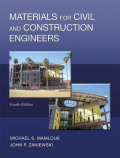Browse All Chapters of This Textbook
Chapter 1 - Materials Engineering ConceptsChapter 2 - Nature Of MaterialsChapter 3 - SteelChapter 4 - AluminumChapter 5 - AggregatesChapter 6 - Portland Cement, Mixing Water, And AdmixturesChapter 7 - Portland Cement ConcreteChapter 8 - MasonryChapter 9 - Asphalt Binders And Asphalt MixturesChapter 10 - Wood
Book Details
This is the eBook of the printed book and may not include any media, website access codes, or print supplements that may come packaged with the bound book. Civil and Construction Engineering Materials: Properties, Uses, and Evaluations Materials for Civil
Sample Solutions for this Textbook
We offer sample solutions for EBK MATERIALS FOR CIVIL AND CONSTRUCTIO homework problems. See examples below:
Chapter 1, Problem 1.1QPChapter 2, Problem 2.1QPChapter 3, Problem 3.1QPChapter 4, Problem 4.1QPNatural aggregates result from the breakdown of large rock masses. Summarize the three basic types...Chapter 6, Problem 6.1QPChapter 7, Problem 7.1QPSolid masonry: It is termed as a masonry unit whose net cross-sectional area Anet in every plane,...Difference between tar and asphalt cement as in Table (1): Asphalt cementTarAsphalt occurs in...
More Editions of This Book
Corresponding editions of this textbook are also available below:
Materials For Civil And Construction Engineers
2nd Edition
ISBN: 9780131477148
Materials for Civil and Construction Engineers (4th Edition)
4th Edition
ISBN: 9780134320533
Pearson eText for Materials for Civil and Construction Engineers -- Instant Access (Pearson+)
4th Edition
ISBN: 9780137505586
Materials for Civil and Construction Engineers (4th Edition)
4th Edition
ISBN: 9780134322896
Materials For Civil And Construction Engineers In Si Units
4th Edition
ISBN: 9781292154404
EBK MATERIALS FOR CIVIL AND CONSTRUCTIO
3rd Edition
ISBN: 9780133002232
Related Civil Engineering Textbooks with Solutions
Still sussing out bartleby
Check out a sample textbook solution.
